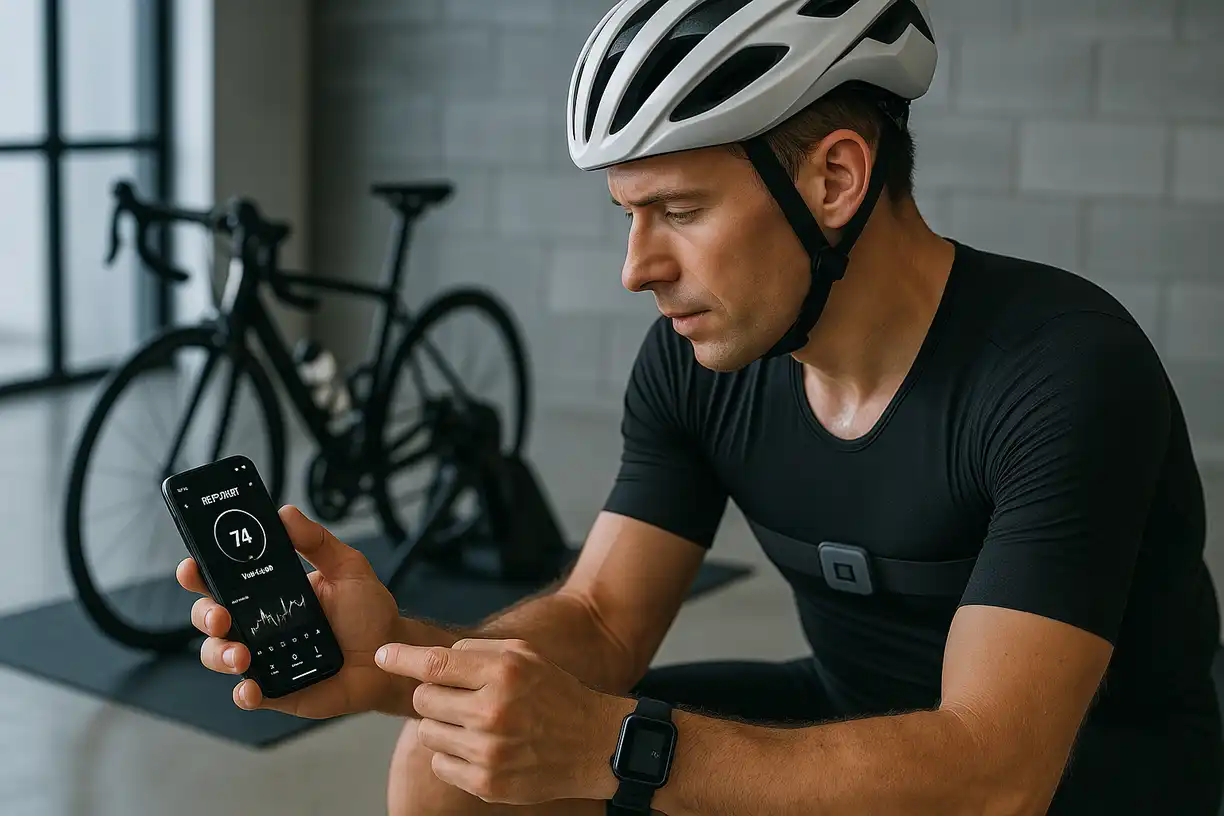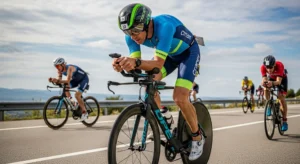The cycling world is experiencing a revolutionary transformation in how athletes approach recovery, and 2025 has emerged as the definitive year where recovery technology has become as sophisticated and essential as training itself. What was once relegated to elite professional teams is now accessible to cyclists at every level, fundamentally changing how we understand and optimize the recovery process.
The paradigm shift toward recovery-focused training represents more than just a trend—it’s a scientific evolution backed by decades of sports science research and enabled by cutting-edge technology. Modern cyclists are discovering that recovery isn’t simply the absence of training; it’s an active, measurable, and optimizable component of performance that can be enhanced through intelligent use of technology and evidence-based protocols.
The Science Behind Modern Recovery Technology
The foundation of cycling recovery technology in 2025 rests on our enhanced understanding of physiological recovery markers and the body’s adaptive responses to training stress. Heart Rate Variability (HRV) has emerged as the gold standard for measuring autonomic nervous system recovery, providing cyclists with real-time insights into their body’s readiness for training intensity.
HRV technology measures the subtle variations in time between heartbeats, offering a window into the balance between the sympathetic and parasympathetic nervous systems. When HRV readings are elevated, it indicates that the parasympathetic nervous system is dominant, suggesting optimal recovery status. Conversely, suppressed HRV values signal that the body is still processing training stress and may benefit from reduced intensity or additional recovery interventions.
The sophistication of modern HRV monitoring extends far beyond simple measurements. Advanced algorithms now analyze HRV trends over time, accounting for individual baselines, training load, sleep quality, and environmental factors. This comprehensive approach provides cyclists with personalized recovery recommendations that adapt to their unique physiological responses and training patterns.
Sleep optimization technology has become equally crucial in the recovery equation. Modern sleep tracking devices don’t merely count hours of sleep—they analyze sleep architecture, measuring time spent in different sleep stages, sleep efficiency, and recovery-specific metrics like deep sleep percentage and REM sleep quality. This data directly correlates with physical recovery, cognitive function, and subsequent training performance.
The integration of multiple recovery metrics creates a comprehensive picture of recovery status that was previously impossible to achieve. Cyclists can now monitor muscle oxygen saturation, core body temperature variations, respiratory rate patterns, and even biochemical markers through non-invasive wearable technology, creating a holistic view of recovery that guides training decisions with unprecedented precision.
Revolutionary Recovery Technologies Transforming Cycling
The landscape of recovery technology available to cyclists in 2025 represents a convergence of multiple scientific disciplines, from exercise physiology and biomechanics to artificial intelligence and materials science. These technologies work synergistically to accelerate recovery processes and optimize training adaptations.
Pneumatic compression therapy has evolved from simple compression garments to sophisticated systems that deliver precisely controlled pressure patterns designed to enhance lymphatic drainage and improve circulation. Modern compression systems utilize gradient pressure profiles that mimic the natural muscle pump mechanism, promoting the removal of metabolic waste products while delivering fresh, oxygenated blood to recovering tissues.
The latest compression therapy devices incorporate biometric feedback, adjusting pressure patterns based on real-time physiological measurements. Heart rate, skin temperature, and even muscle tension sensors inform the compression algorithms, ensuring that each recovery session is optimized for the individual’s current physiological state. This personalized approach maximizes the effectiveness of compression therapy while minimizing the risk of over-treatment.
Percussive therapy technology has undergone significant advancement, with devices now featuring intelligent amplitude and frequency modulation based on muscle tension feedback. These devices use accelerometer and pressure sensors to detect muscle density and adjust treatment parameters accordingly, providing targeted therapy that adapts to different muscle groups and recovery needs.
Cold therapy and heat therapy technologies have been revolutionized through precise temperature control and targeted application methods. Cryotherapy chambers now offer programmable temperature profiles that can target specific recovery phases, while infrared therapy devices provide deep tissue heating with unprecedented precision. The combination of these thermal therapies, guided by recovery monitoring data, creates powerful recovery protocols that accelerate healing and reduce inflammation.
Electrical muscle stimulation (EMS) technology has evolved to include sophisticated waveform patterns that can target different aspects of recovery, from promoting blood flow and reducing muscle tension to facilitating active recovery through gentle muscle contractions. Modern EMS devices integrate with recovery monitoring systems to automatically adjust stimulation parameters based on recovery status and training load.
AI-Powered Recovery Optimization and Personalization
The integration of artificial intelligence into recovery technology represents perhaps the most significant advancement in cycling recovery science. AI algorithms analyze vast amounts of physiological data to identify patterns and correlations that would be impossible for human analysis to detect, creating personalized recovery protocols that adapt continuously to changing conditions.
Machine learning models trained on thousands of athlete datasets can predict optimal recovery strategies based on training load, environmental conditions, sleep quality, nutrition status, and individual physiological characteristics. These AI systems learn from each athlete’s unique responses to different recovery interventions, continuously refining their recommendations to maximize recovery effectiveness.
Predictive recovery modeling uses AI to forecast recovery timelines and identify potential overtraining risks before they manifest as performance decrements or injury. By analyzing trends in HRV, sleep quality, training load, and subjective wellness markers, AI systems can alert cyclists to adjust their training or implement additional recovery interventions before problems develop.
The personalization capabilities of AI-powered recovery systems extend to nutrition timing and composition recommendations. By analyzing training demands, recovery status, and individual metabolic characteristics, AI can suggest optimal post-exercise nutrition strategies that support recovery processes and enhance training adaptations.
Recovery periodization, traditionally based on general principles and coach experience, is now informed by AI analysis of individual recovery patterns and training responses. AI systems can identify optimal recovery timing within training cycles, suggesting when to implement intensive recovery interventions and when lighter recovery methods are sufficient.
Wearable Technology and Continuous Recovery Monitoring
The evolution of wearable technology has made continuous recovery monitoring a reality for cyclists at all levels. Modern wearables go far beyond basic activity tracking, providing sophisticated physiological monitoring that rivals laboratory-grade equipment in accuracy and reliability.
Advanced heart rate monitors now incorporate multiple sensors that measure not only heart rate but also heart rate variability, respiratory rate, and even blood oxygen saturation. These multi-parameter devices provide comprehensive cardiovascular recovery monitoring that can detect subtle changes in recovery status throughout the day.
Muscle oxygen saturation monitors use near-infrared spectroscopy to measure oxygen levels in working muscles, providing direct feedback on muscle recovery status and readiness for training. This technology allows cyclists to monitor recovery at the tissue level, identifying when muscles have fully replenished oxygen stores and cleared metabolic waste products.
Core body temperature monitoring through continuous temperature sensors provides insights into circadian rhythm optimization and recovery status. Body temperature patterns correlate strongly with sleep quality, hormonal balance, and overall recovery, making continuous temperature monitoring a valuable tool for recovery optimization.
Hydration monitoring technology uses bioimpedance analysis to assess fluid balance and electrolyte status, crucial factors in recovery optimization. Proper hydration supports all recovery processes, from nutrient transport and waste removal to temperature regulation and cellular repair mechanisms.
The integration of multiple wearable devices creates a comprehensive recovery monitoring ecosystem that provides 24/7 insights into recovery status. Data fusion algorithms combine information from multiple sensors to create recovery scores and recommendations that account for all measured parameters, providing cyclists with clear, actionable guidance for recovery optimization.
Recovery Nutrition Technology and Timing Optimization
The intersection of nutrition science and recovery technology has produced sophisticated systems for optimizing post-exercise nutrition timing and composition. Smart nutrition platforms analyze training data, recovery status, and individual metabolic characteristics to provide personalized nutrition recommendations that support optimal recovery.
Continuous glucose monitoring, originally developed for diabetes management, has found applications in sports recovery by providing real-time feedback on metabolic recovery status and nutrient utilization. Cyclists can monitor how different foods and timing strategies affect their metabolic recovery, allowing for precise optimization of post-exercise nutrition.
Hydration optimization technology goes beyond simple fluid replacement, analyzing sweat composition and electrolyte losses to recommend personalized hydration strategies. Smart water bottles and hydration monitoring systems track fluid intake and provide feedback on hydration status, ensuring optimal fluid balance for recovery.
Supplement timing optimization uses AI analysis of training demands and recovery status to recommend when and what supplements might support recovery processes. Rather than generic supplementation protocols, these systems provide personalized recommendations based on individual needs and recovery goals.
Sleep Technology and Recovery Optimization
Sleep represents the most critical recovery period for cyclists, and 2025 has brought unprecedented sophistication to sleep optimization technology. Modern sleep tracking goes far beyond counting hours, analyzing sleep architecture, recovery-specific sleep metrics, and environmental factors that influence sleep quality.
Smart sleep environments use automated systems to optimize bedroom conditions for recovery-focused sleep. Temperature control, humidity management, light exposure, and even sound optimization are automatically adjusted based on individual sleep patterns and recovery needs.
Sleep stage optimization technology can identify when individuals spend optimal time in deep sleep and REM sleep phases, the most critical stages for physical and cognitive recovery. This information guides sleep timing recommendations and identifies factors that may be disrupting recovery-critical sleep stages.
Circadian rhythm optimization uses light therapy and timing recommendations to align sleep patterns with natural circadian rhythms and training schedules. Proper circadian alignment enhances sleep quality and supports the hormonal processes that drive recovery and adaptation.
Integration with Training Platforms and Periodization
The most sophisticated recovery technology systems integrate seamlessly with training platforms and periodization software, creating comprehensive training and recovery ecosystems that optimize both training stress and recovery interventions.
Training load analysis algorithms consider not only the volume and intensity of training but also the recovery capacity and status of the individual athlete. This integration allows for dynamic training adjustments based on recovery status, preventing overreaching while maximizing training adaptations.
Recovery periodization uses data-driven approaches to plan recovery interventions within training cycles. Rather than generic recovery protocols, these systems recommend when to implement intensive recovery interventions, when lighter recovery methods are sufficient, and how to time recovery relative to training goals and competition schedules.
Adaptive training systems automatically adjust training recommendations based on recovery status, ensuring that training intensity and volume remain appropriate for the athlete’s current recovery capacity. This prevents the accumulation of excessive fatigue while maintaining optimal training stimulus.
Practical Implementation for Different Cycling Disciplines
The application of recovery technology varies significantly across different cycling disciplines, with each requiring specific approaches to recovery optimization. Road cyclists, mountain bikers, track cyclists, and recreational riders all benefit from different aspects of recovery technology based on their unique training demands and recovery needs.
Road cycling recovery technology focuses heavily on cardiovascular recovery monitoring and endurance-specific recovery interventions. Long training rides and races create specific recovery demands that benefit from targeted cardiovascular recovery monitoring and interventions designed to support aerobic system recovery.
Mountain biking recovery technology emphasizes neuromuscular recovery and injury prevention, given the high-impact nature of off-road cycling. Recovery protocols for mountain bikers often include more emphasis on muscle recovery technology and injury prevention interventions.
Track cycling recovery technology focuses on power and speed recovery, with emphasis on neuromuscular system recovery and the specific demands of high-intensity, short-duration efforts. Recovery protocols are often designed around the unique demands of track cycling training and competition.
For recreational cyclists, recovery technology provides accessible tools for improving training consistency and enjoyment. Even basic recovery monitoring can help recreational cyclists avoid overtraining and maintain consistent training progress.
Cost-Benefit Analysis and Accessibility
The democratization of recovery technology has made sophisticated recovery monitoring accessible to cyclists across all budget ranges. While professional-grade recovery technology can represent significant investments, entry-level options provide substantial benefits at accessible price points.
Basic HRV monitoring can be achieved through smartphone apps and chest strap heart rate monitors, providing fundamental recovery insights at minimal cost. These basic systems offer many of the benefits of more expensive systems while remaining accessible to budget-conscious cyclists.
Mid-range recovery technology systems provide comprehensive monitoring capabilities that rival professional systems at a fraction of the cost. These systems typically include multiple monitoring parameters and basic AI-powered recommendations, offering excellent value for serious recreational and competitive cyclists.
Professional-grade recovery technology systems provide the most sophisticated monitoring and intervention capabilities but require significant investment. These systems are typically justified for competitive athletes and serious enthusiasts who can benefit from the most advanced recovery optimization capabilities.
Future Developments and Emerging Technologies
The future of cycling recovery technology promises even more sophisticated and accessible solutions. Emerging technologies in development include non-invasive biomarker monitoring, advanced AI prediction models, and integration with genetic testing for personalized recovery optimization.
Biomarker monitoring technology is developing toward non-invasive measurement of hormonal and metabolic markers that provide direct insights into recovery status. These technologies could provide unprecedented insights into recovery processes without the need for blood sampling or laboratory analysis.
Advanced AI models are being developed that can predict optimal recovery strategies based on genetic profiles, training history, and environmental factors. These systems promise to provide highly personalized recovery recommendations that account for individual genetic predispositions and unique physiological characteristics.
Integration with genetic testing could provide insights into individual recovery characteristics and optimal recovery strategies based on genetic markers related to recovery capacity, inflammation response, and adaptation potential.
Conclusion: Embracing the Recovery Revolution
The cycling recovery technology revolution of 2025 represents a fundamental shift in how cyclists approach training and performance optimization. Recovery is no longer an afterthought or a passive process—it has become an active, measurable, and optimizable component of training that can significantly impact performance outcomes.
The integration of sophisticated monitoring technology, AI-powered optimization, and evidence-based recovery interventions provides cyclists with unprecedented tools for recovery optimization. From basic HRV monitoring to comprehensive recovery ecosystems, technology now supports recovery optimization at every level of cycling participation.
The key to successful implementation of recovery technology lies in understanding that technology is a tool to support evidence-based recovery practices, not a replacement for fundamental recovery principles. Proper sleep, nutrition, hydration, and stress management remain the foundation of effective recovery, with technology providing the insights and optimization needed to maximize these fundamental practices.
As recovery technology continues to evolve, cyclists who embrace these tools while maintaining focus on fundamental recovery principles will gain significant advantages in training consistency, performance optimization, and long-term cycling enjoyment. The recovery revolution is not just changing how we recover—it’s changing how we think about training, performance, and the pursuit of cycling excellence.
For cyclists looking to optimize their recovery and performance, the integration of recovery technology represents one of the most impactful investments they can make in their cycling journey. Whether through basic HRV monitoring or comprehensive recovery ecosystems, the tools are now available to transform recovery from guesswork into a precise, optimized component of training success.




